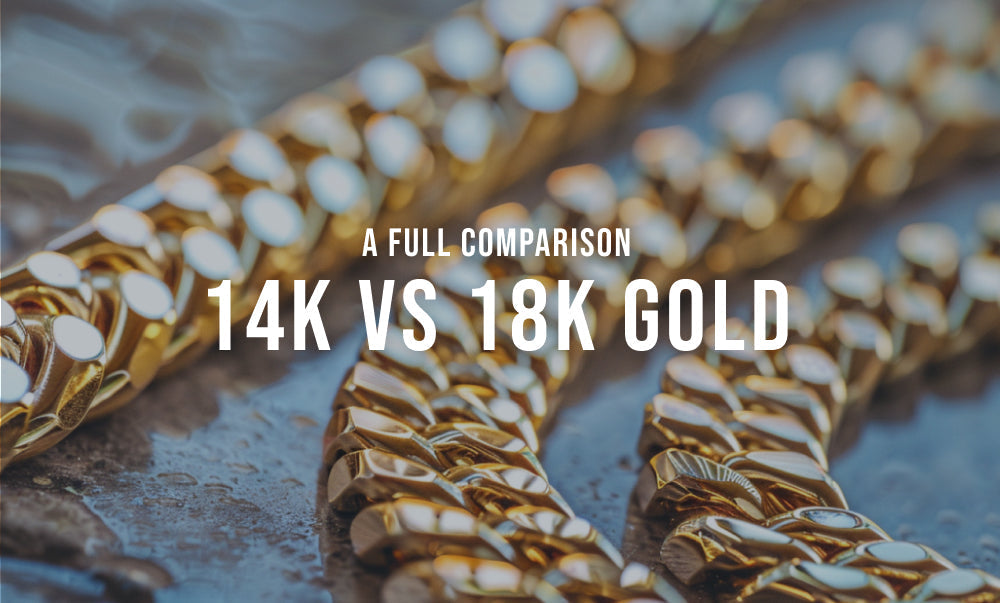
Gold, a timeless emblem of wealth and elegance, has fascinated people for thousands of years. However, when choosing gold jewelry, a frequent question arises – should you choose 10k or 14k gold? This inquiry is significant, as the choice can greatly affect the jewelry's durability, aesthetic appeal, and cost. Fortunately, this guide will clarify the nuances of gold purity and help you make a well-informed choice.
Key Takeaways
- The purity of gold in 10k and 14k jewelry influences its quality, longevity, appearance, and price.
- 10K gold is more durable & affordable. 14K has a warmer hue but higher price point & may cause skin irritation.
- The choice between 10K and 14K should reflect your personal preferences for jewelry use or investment.
Understanding Gold Purity: 10k vs 14k

The quality, longevity, and visual appeal of jewelry are significantly determined by its gold purity, which indicates the percentage of gold present. The karat system, which quantifies gold purity, shows that 10k yellow gold is 41.7% pure, whereas 14k yellow gold is 58.3% pure. Thus, 14k gold has a greater gold content.
This slight variation can greatly affect different characteristics of your jewelry. Although both types shine brightly, 10k gold has a somewhat less vibrant yellow color compared to 14k gold, attributed to the higher amount of alloy metals in 10k gold, which also enhances its durability and affordability.
Decoding the Karat System

Understanding the Karat System
Grasping the karat system is essential for making informed decisions regarding your gold jewelry. This system measures the proportion of pure gold to other alloys in the jewelry, which helps ascertain its purity. It is important to note that this concept is distinct from the carat system used for measuring gemstone weight.
The primary gold options, 10k and 14k, consist of different proportions of gold and alloy metals. Specifically, 10k gold comprises 41.7% gold, while 14k gold contains 58.3% gold. Alloy metals like copper, nickel, and silver are added to improve the durability of the jewelry, making them ideal for fine gold pieces.
Main Differences Between 10K and 14K Gold
The choice between 10K and 14K gold hinges on their key differences in:
- Durability
- Color
- Price
- Skin sensitivity
By exploring these differences, you will gain valuable insights to assist in your decision-making process, whether selecting a diamond engagement ring, wedding rings, bracelets, or any other gold jewelry, including diamond pieces.
Durability
In terms of durability, 10K gold is superior due to its higher alloy metal content, which enhances its durability and scratch resistance, making it a great option for everyday jewelry like rings and bracelets.
The inclusion of metals such as copper and nickel increases the hardness of the gold, making it more suitable for regular wear. This durability aspect of 10K gold is particularly advantageous for those who prioritize longevity in their jewelry.
Color and Appearance
When it comes to color and appearance, 14K gold, including white gold, is more visually appealing. Its greater gold content results in a richer, warmer yellow color, which is important for those who appreciate the traditional gold look.
In contrast, 10K gold has a lighter, less vibrant yellow shade and may even take on a pinkish hue due to the higher copper content in its alloys. This visual distinction could be a crucial factor for individuals who value the aesthetic qualities of their jewelry.
Price Point
For many individuals, the cost plays a crucial role in choosing between 10K and 14K gold. Typically, 10K gold is less expensive than 14K gold due to its lower gold content, making it a more budget-friendly option for those with financial constraints.
The current market price for 10K gold is around $27.11 per gram. However, it is essential to note that the purity of gold significantly affects its price; higher purity gold is priced higher, while lower purity gold, which contains a greater percentage of other metals, is valued less.
Sensitivity For Skin
It is crucial to take into account the sensitivity of the skin. 14K gold, having a greater gold content, is generally less prone to causing skin irritation compared to 10K gold, which has a higher amount of potentially allergenic metals such as nickel.
In fact, metals like copper, silver, and zinc, which are often mixed with gold in 10K and 14K jewelry, can lead to skin irritation for some individuals. This aspect is particularly important for those who have known metal sensitivities.
Benefits of 10K Gold
Firstly, it is significantly more affordable than higher karat alternatives like 14K gold, making it a practical choice for those on a budget.
Additionally, 10K gold is more durable because of its greater content of alloy metals. Its impressive hardness and resistance to scratches make it perfect for jewelry that is worn regularly, such as everyday bracelets and rings.
Benefits of 14K Gold
On the other hand, 14K gold presents distinct benefits. Its higher gold content results in a richer hue, appealing to those who appreciate the traditional look of gold.
Additionally, 14K gold is less prone to causing skin irritation, making it an ideal option for individuals with sensitive skin. Its widespread availability and comfort for extended wear contribute to its popularity in fine jewelry, including engagement rings, wedding bands, and necklaces.
Ucciyo incorporates 14K gold in its jewelry collection, offering both solid and gold-plated choices. Explore our range of chains, rings, bracelets, and more!
Disadvantages of 10K Gold
Opting for 10K gold, like any choice, comes with its own drawbacks. It lacks the luxurious feel associated with higher karat gold due to its lower purity, and its lighter color and less vibrant yellow tone may not satisfy those who favor a deeper gold aesthetic.
Additionally, the higher concentration of alloy metals in 10K gold increases the likelihood of skin reactions in people who are sensitive to certain metals such as copper and nickel, potentially resulting in discomfort and a diminished perception of quality.
Disadvantages of 14K Gold
The premium cost associated with 14K gold may deter certain individuals from purchasing it. Its higher gold content, which enhances its value and price, may exceed the financial means of some consumers.
Additionally, 14K gold is marginally less durable than 10K gold, which could affect the lifespan of jewelry crafted from it in comparison to pieces made from 10K gold. Although it remains appropriate for everyday wear, its greater gold content makes it more vulnerable to scratches and dents, as gold is a softer metal.
Jewelry Types: Best Uses for 10k and 14k Gold

The choice between 10K and 14K gold often depends on the specific type of jewelry being considered. 10K gold is particularly well-suited for everyday wear and heirloom items, making it a practical option for individuals looking for affordability while still ensuring durability.
On the other hand, 14K gold is most suitably used in fine jewelry such as:
The durability and comfort of wearable jewelry make it an ideal option for important pieces, in addition to other types of wearable adornments.
Investment Perspective: Resale Value and Heirloom Potential
From an investment standpoint, gold is often viewed as a commendable choice due to its longevity, potential resale value, and the possibility of being passed down as an heirloom.
The resale value of 10K and 14K gold jewelry is influenced by several factors, including:
- The purity of the gold
- The weight of the jewelry
- Current market prices for gold
- The overall condition and quality of the piece
The average resale price for 10K gold jewelry is around $25 per gram; however, factors like craftsmanship and design can influence this value. It is important to note that solid gold retains a significantly higher resale value and has a longer lifespan compared to gold-filled, vermeil, and plated alternatives, owing to its higher gold content.





